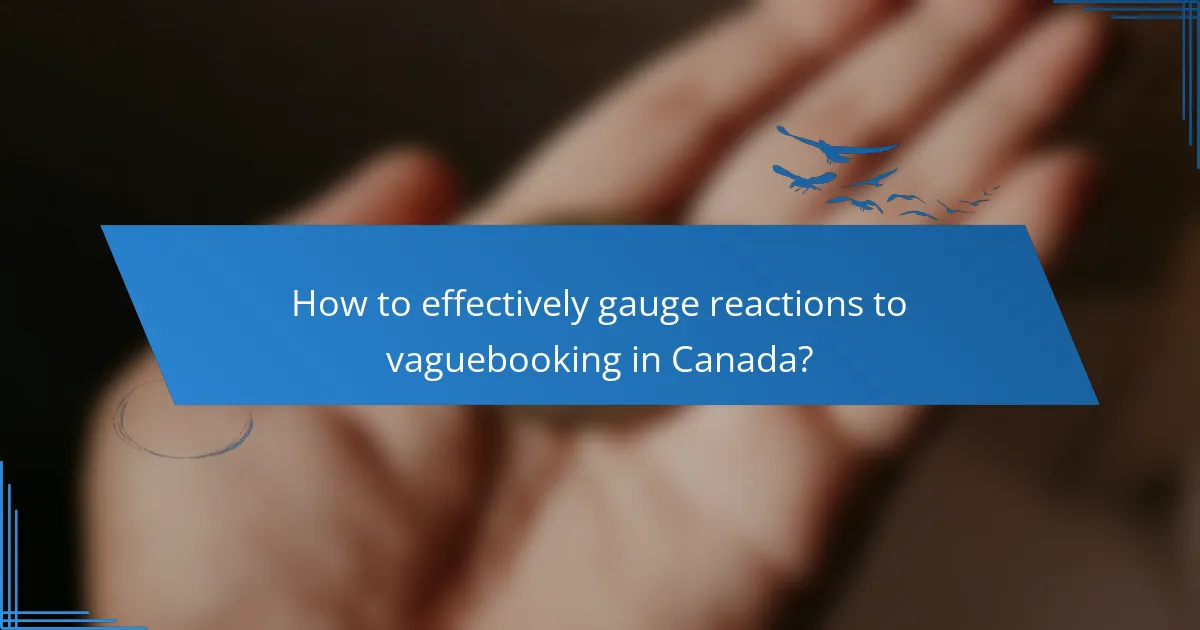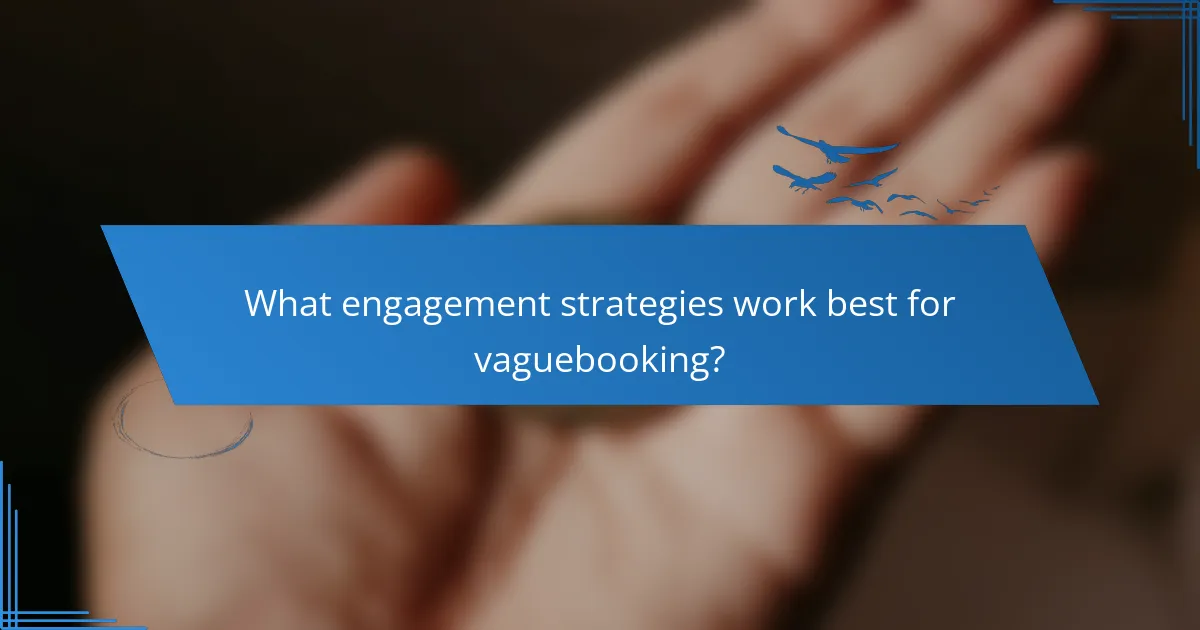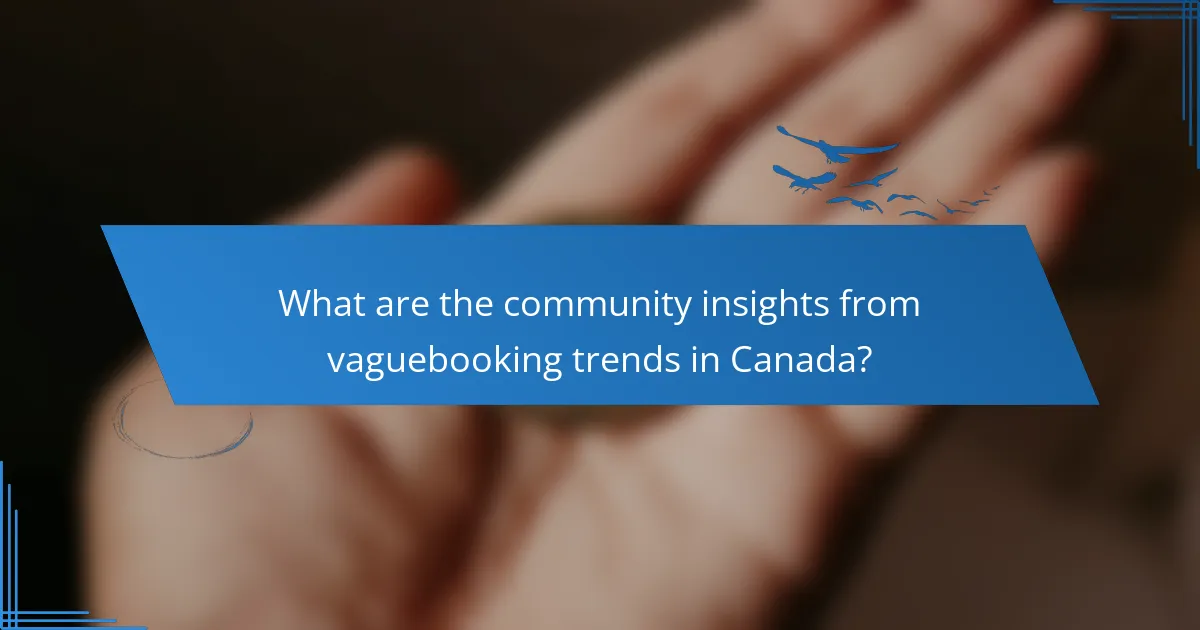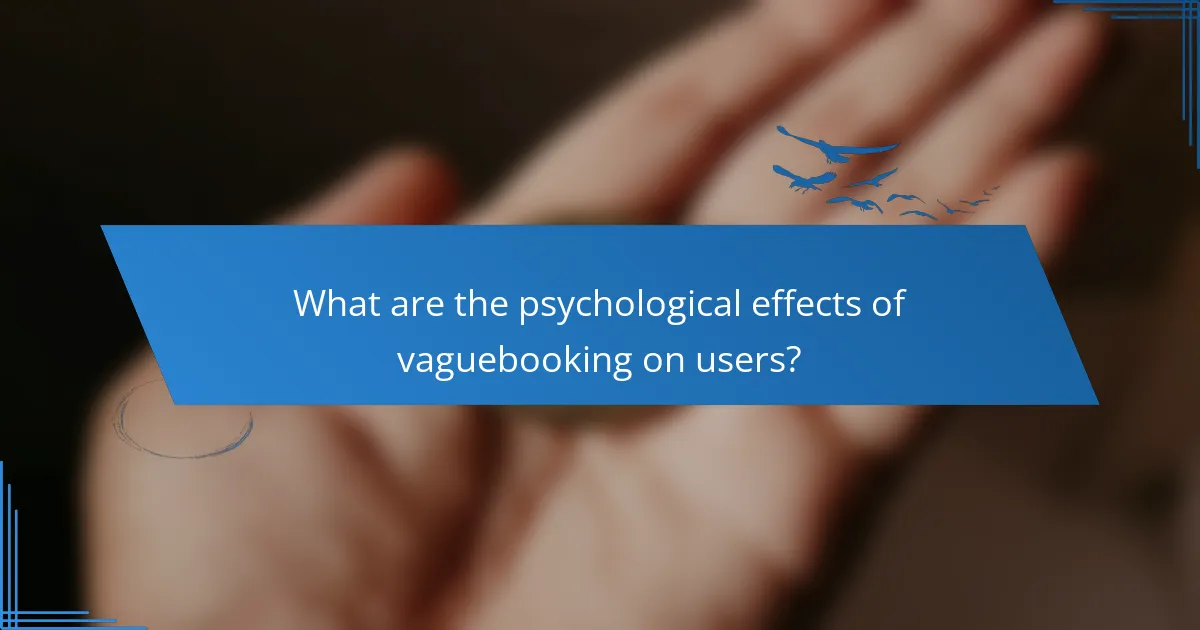Vaguebooking, the practice of posting ambiguous messages on social media, has become a notable trend in Canada, reflecting unique community behaviors and engagement strategies. By analyzing engagement metrics and comment sentiment, individuals and brands can better understand audience reactions and refine their social media approaches. Effective strategies include crafting intriguing questions and using emotional triggers to foster interaction and build a sense of community among followers.

How to effectively gauge reactions to vaguebooking in Canada?
To effectively gauge reactions to vaguebooking in Canada, focus on analyzing engagement metrics, comment sentiment, and audience interactions. Understanding how users respond can help refine your social media strategy and enhance community engagement.
Utilize engagement metrics
Engagement metrics are essential for assessing how well your vaguebooking posts resonate with your audience. Key metrics include likes, shares, and comments, which provide insight into user interest and interaction levels.
For example, a post with a high number of comments but low likes may indicate that users are intrigued but unsure about the content. Regularly track these metrics to identify trends and adjust your content strategy accordingly.
Monitor comment sentiment
Sentiment analysis of comments can reveal how your audience feels about vaguebooking posts. Positive, negative, and neutral sentiments can help you understand the emotional response to your content.
Consider using tools that analyze sentiment automatically, allowing you to quickly gauge community reactions. Engaging with comments can also provide direct feedback and foster a sense of community.
Analyze share rates
Share rates indicate how often your vaguebooking posts are shared by users, reflecting their perceived value and relevance. A high share rate suggests that your content resonates well with your audience, prompting them to spread the word.
Monitor which types of posts are shared most frequently to identify successful themes or topics. This can guide future content creation and help you connect more effectively with your audience.
Conduct audience polls
Audience polls are a direct way to gather feedback on vaguebooking content. By asking specific questions about your posts, you can gain valuable insights into what your audience appreciates or finds confusing.
Use platforms like Instagram or Twitter to create quick polls, allowing for real-time feedback. This interactive approach not only engages your audience but also helps tailor your content to their preferences.
Track post reach
Tracking post reach helps you understand how many users see your vaguebooking content. A higher reach indicates that your posts are being distributed widely, which is crucial for maximizing engagement.
Utilize analytics tools to monitor reach over time and correlate it with engagement metrics. This can help you identify the best times to post and the types of content that attract the most viewers.

What engagement strategies work best for vaguebooking?
Effective engagement strategies for vaguebooking include crafting intriguing questions, using emotional triggers, incorporating multimedia elements, and encouraging user-generated content. These methods can stimulate interaction and foster a sense of community among followers.
Craft intriguing questions
Asking thought-provoking questions can spark curiosity and prompt followers to engage with your vague posts. Aim for open-ended questions that invite personal reflections or opinions, such as “What do you think is the most challenging part of change?”
Consider the context of your audience when formulating these questions. Tailoring them to current events or shared experiences can increase relatability and response rates.
Use emotional triggers
Emotional triggers can significantly enhance engagement by resonating with your audience’s feelings. Posts that evoke nostalgia, excitement, or even curiosity can lead to higher interaction levels.
For instance, sharing a vague statement that hints at a personal struggle or triumph can encourage followers to share their own experiences, fostering a deeper connection within the community.
Incorporate multimedia elements
Using images, videos, or GIFs alongside vague posts can capture attention and enhance engagement. Visual content often conveys emotions and messages more effectively than text alone.
Experiment with different formats, such as a short video that teases a story or an evocative image that complements your vague statement. This approach can make your posts more appealing and shareable.
Encourage user-generated content
Inviting followers to share their thoughts or experiences related to your vague posts can create a sense of ownership and community. This could be as simple as asking them to comment with their interpretations or share their own vague thoughts.
Consider running contests or challenges that prompt followers to create content based on your vague themes. This not only boosts engagement but also enriches your community with diverse perspectives.

What are the community insights from vaguebooking trends in Canada?
Vaguebooking trends in Canada reveal significant insights into community behavior, as users often post ambiguous messages to elicit reactions from their social circles. This practice can enhance engagement but also leads to varied interpretations and responses from audiences.
Identify common themes
Common themes in vaguebooking include expressions of frustration, seeking validation, or hinting at personal struggles without full disclosure. Users often share cryptic messages about relationships, work stress, or life changes, which can resonate with others experiencing similar situations.
Analyzing these themes helps identify what topics generate the most engagement. For instance, posts about mental health or relationship issues tend to attract supportive comments and shares, indicating a community that values empathy and connection.
Understand audience demographics
The demographics of vaguebooking audiences in Canada vary widely, but younger users, particularly those aged 18-34, are more likely to engage in this behavior. This age group often seeks social validation and connection through their online presence.
Additionally, gender differences can influence vaguebooking trends, with studies suggesting that women may use this tactic more frequently to express emotional states, while men might focus on more general life updates. Understanding these demographics can help tailor content that resonates with specific groups.
Evaluate platform preferences
Different social media platforms attract varying levels of vaguebooking activity. Facebook remains a popular choice for vague posts due to its broad user base and ability to foster discussions among friends and family.
Instagram and Twitter also see vaguebooking, but the formats differ; Instagram often relies on visuals paired with ambiguous captions, while Twitter’s character limit can lead to more cryptic messages. Marketers should consider these platform preferences when crafting engagement strategies to connect with audiences effectively.

How does vaguebooking impact social media engagement?
Vaguebooking can significantly enhance social media engagement by prompting users to react, comment, or inquire further about ambiguous posts. This strategy leverages curiosity and emotional responses, often leading to increased interaction and visibility.
Increases user interaction
Vaguebooking encourages users to engage more actively with posts, as they often feel compelled to comment or ask for clarification. This interaction can manifest as likes, shares, or direct messages, creating a dynamic conversation around the post.
For example, a post that simply states, “Feeling overwhelmed today,” may prompt friends to reach out with supportive comments or questions, thereby increasing the overall interaction rate on that post.
Boosts post visibility
Posts that generate more comments and reactions tend to be favored by social media algorithms, resulting in greater visibility. When users engage with vague posts, they signal to the platform that the content is interesting, which can lead to wider distribution among friends and followers.
As a practical tip, using vague statements can be a strategic way to ensure your content appears more frequently in feeds, increasing the likelihood of reaching a larger audience.
Encourages community discussions
Vaguebooking often sparks broader discussions within communities, as users share their interpretations and experiences related to the ambiguous content. This can create a sense of belonging and connection among members, fostering a supportive environment.
For instance, a post like “This week has been tough” can lead to a variety of responses, with users sharing their own challenges and advice, thus enriching the community dialogue and engagement.

What are the psychological effects of vaguebooking on users?
Vaguebooking can lead to a range of psychological effects on users, including heightened anxiety, increased social validation needs, and feelings of isolation. Users may seek attention or support through ambiguous posts, which can create a cycle of emotional dependence on social media interactions.
Emotional Responses to Vaguebooking
When users engage in vaguebooking, they often experience a mix of anticipation and frustration. The lack of clarity in posts can provoke curiosity among friends, leading to comments and inquiries. However, this can also result in feelings of disappointment if the responses do not meet their emotional expectations.
Impact on Social Relationships
Vaguebooking can strain social relationships, as friends may feel compelled to respond to unclear messages. This pressure can lead to misunderstandings and resentment, particularly if the original poster does not clarify their intent. Over time, this behavior may alienate friends who grow tired of the ambiguity.
Engagement Strategies for Vaguebooking
To effectively engage with vaguebooking, users should consider balancing their posts with clearer communication. For instance, they might share a vague sentiment followed by a more explicit follow-up to provide context. This approach can maintain interest while fostering deeper connections.
Community Insights on Vaguebooking
Communities often develop their own norms around vaguebooking, influencing how users perceive and respond to such posts. In some groups, vaguebooking may be seen as a cry for help, prompting supportive responses, while in others, it might be viewed as attention-seeking behavior. Understanding these dynamics can help users navigate their social circles more effectively.
